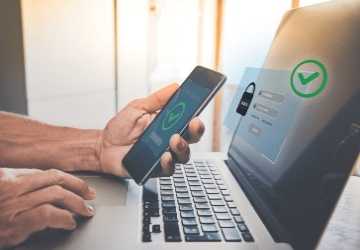How to Prevent Phishing Attacks
Protect yourself from phishing attacks with our essential guide. Learn effective strategies to safeguard your information online. Stay safe and secure!
Phishing is a continually evolving threat in today's environment, where the reliance on the Internet is increasing.
Such misrepresentation can cause disastrous effects, including identity theft, loss of cash, and data violations. The latest reports show that phishing attacks rose 61% in 2022 alone.
But fear not!

In this blog post, we will provide helpful information and ways to avoid becoming a victim of phishing. By practicing these small but effective rules, you will be protected and able to navigate the World Wide Web easily.
Let's enroll immediately and understand how to strengthen your shields against such phishing attempts.
The Importance of Being Proactive Against Phishing Attacks
Phishing attacks, if you get caught in them, have a ripple effect of consequences that go beyond the act itself.
Monetary losses always occur, and these can be severe, making it difficult to make repairs after the losses are incurred.
Identity theft and unauthorized access to other accounts with login information, Social Security number, credit card details, and other personal details.
Furthermore, the negative impacts on your reputation are hard to address.
Cyber phishing may lead to malware distribution to the contacts, straining interpersonal and work relations. The damage that deception and violation do to individuals' psychological health can also be felt.
This way, you will be more prepared and know how to avoid falling victim to phishing attacks, which will, in the long run, make your online use more secure.
Learning what you need to do to protect yourself and valuable information will put you in a position to face the digital world confidently.
Practical Strategies to Prevent Phishing Attacks
To ensure your online security, you must consider measures to avoid phishing attacks. Now, let's explore the best ways to detect and eliminate these threats.
1. Recognize Phishing Emails
The first and basic level of protection against phishing attacks is recognizing a phishing email.
Keep an eye on the email addresses in the messages that do not correspond to the sender's assumed personage.
Silly spelling and grammatical mistakes in the subject line or the actual body of the email could be more credible.
Phishers are always very keen on their language; they use words like 'urgency,' making you act without thinking. For example, an email with a message;
"Your account will be suspended if you do not click this link and instantly log in", which is a phishing message.
2. Verify Links Before Clicking
Always pass the cursor over the links in an email to see whether the link is genuine.
The destination URL should also resemble the content of the email and the organization/individuality of the sender.
Avoid clicking on shortened URLs, as they can be misleading. If you doubt a link's legitimacy, type the URLs and visit the site instead.
3. Use Strong, Unique Passwords
Using excellent and different passwords in all your accounts is very important if you do not want someone else to access your account.
Technically, a good password should consist of a combination of uppercase and lowercase letters—numbers and special symbols.
It is advisable to use password characters that are not easily predicted, such as birthdays or names. Using different passwords for different accounts is a wise way of protecting your accounts from being hacked because even if one account is hacked, the others are safe.
You might also need a reliable password generator that safely creates and saves passwords.
4. Enable Two-Factor Authentication (2FA)
Two-factor authentication provides added security to your accounts. To log in, 2FA requires a secondary identification method, such as a code from your phone, a fingerprint scan, and a password.
It means that even if a phisher has your password, they cannot log into your account without the second factor.
Always turn on 2FA when available for all essential and mainly financial accounts, such as banking and email.

5. Keep Software Updated
Updating the operating system, browsers, and security software as often as possible is also highly effective at preventing phishing attacks.
Indeed, new software releases contain fixes for specific weaknesses actively used by phishers. These fixes plug holes in your security, making it difficult for attackers to penetrate your system. Allow updating to check that you have the latest security updates.
6. Educate Yourself and Others
It is necessary to constantly update the information on the new types of phishing activities.
It is advisable to become habitual in reviewing new techniques used by phishing attackers and how to deal with them.
Spread the word of this knowledge to friends, relatives, and co-workers to ensure everyone is safe online. Should you feel you are being phished, report this to the relevant authorities or the company being impersonated.
To a certain degree, you and others are safeguarding the community against the consequences of phishing attacks.
Take Control: Secure Against Phishing Attacks!
If you apply the measures described in this article, your chances of getting caught by a phishing attack will be minimized.
Please act now to protect your online reputation and business before it is too late.
Check your security options, turn on two-step verification, and always download the latest version of your software.
The best way is to avoid falling for a phishing attempt, which is why prevention is always the best solution.
Begin implementing these preventive measures today and be assured of being more shielded against such risks.
Frequently Asked Questions
Q. What should I do if I suspect a phishing email?
Ans. Do not take action from the messages, such as clicking links or downloading attachments. Instead, forward the email to your IT department, email service provider, or the company being mimicked.
Q. Can phishing attacks happen on mobile devices?
Ans. Yes, phishing attacks can occur on any device, including PCs, laptops, smartphones, and tablets. One must always be careful with any unexpected message, link, or attachment, no matter the device on which it was received.
Q. How do I know if my information has been compromised?
Ans. It also helps to check your accounts occasionally for suspicious activity, such as transactions without your consent or changes to your details. To be even more secure, you should sign up for a credit monitoring service.
Q. Is antivirus software enough to protect against phishing?
Ans. Of course, antivirus software helps identify and prevent many phishing attacks, but it is far from perfect. However, constant awareness and learning about phishing techniques are the keys to overall protection.
Q. What should I do if I've fallen victim to a phishing attack?
Ans. Suppose you think you clicked on the link and became a victim of a phishing attack. In that case, you should first change your passwords, call the authorities or companies that were attacked, and monitor your accounts for any suspicious activities.